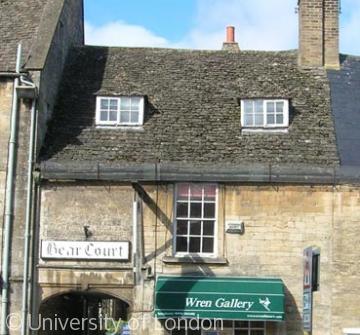High Street (west): no 34 (former Bear Inn)

The Bear Inn was established here probably in the late 1640s by Thomas Matthews (died 1680). Parts of this complex series of buildings are earlier however: 16th-century features include a Tudor-arched fire surround, and in a ground-floor room a large kitchen fireplace with a former bread oven. When the inn was opened, existing buildings were probably remodelled. Many of the surviving timbers are re-used, and the gateway and street-front are probably 17th-century, while the neighbouring Falkland Hall seems to have been adapted as a lodging range soon after (Panel 1). An external stairway behind the gateway led to the inn’s upper storey. To the rear, there was a through-route to Priory Lane until the modern school playground was extended. Two fashionable Georgian windows shown in J.C. Buckler’s watercolour of 1821 were inserted in the 18th century, though only the first-floor one now survives.
The original inn closed between 1760 and 1774, and in the early 19th century the stables in the courtyard (now shops and showrooms) seem to have been converted into cottages, as evidenced by the chimney stacks. John Jones, a carpenter who bought this building and Falkland Hall in 1830, re-opened the inn some ten years later. By the 1910s it was owned by Clinch & Co. of Witney, and continued as an inn until the 1960s. Thereafter it was remodelled as shops and renamed Bear Court.
(Photo by Michael and Rosemary Howden, Oxfordshire Buildings Record)
See: M Laithwaite,'Buildings of Burford', in A Everitt (ed), Perspectives in English Urban History (1973) 4; R Moody, Inns of Burford (2007), 34–6
Content generated during research for the paperback book 'Burford: Buildings and People in a Cotswold Town' (ISBN 13 : 9781860774881) for the England's Past for Everyone series


